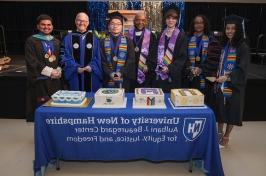
Meticulously detailed model of a Chalcidoid 研究小组根据黄蜂的3D图像制作了这张图片.
A study of a previously undescribed group of parasitic wasps has uncovered new information about their mandible, or jaw, function. The discovery is an intriguing development in insect evolution — one that scientists believe led to the remarkable diversification of the Chalcidoidea superfamily of wasps.
The team’s work, which includes contributions by István Mikó, the manager of the 联合国儿童基金会昆虫和其他节肢动物收藏, was recently published in the Proceedings of the Royal Society.
Mandibles — the set of jaws near an insect’s mouth — are commonly used to grip, 咬、切食物,防御掠食者或对手. The earliest known insects had mandibles that rotated inside a single ball-and-socket joint — like your arm and leg — and had highly flexible movement. Then, beginning about 400 million years ago, the ancestors of modern insects developed mandibles with two joints that restricted their movement to a single plane but gave them a more powerful bite and, in turn, access to new food sources.
“This is one of the key innovations that triggered the extreme diversification of insects, 它们现在占地球上所有动物物种的四分之三,” says Mikó.
But this change did not offer the same advantages to the predominantly parasitoid species that make up the Chalcidoidea family of insects because the main function of their mandibles is not feeding. 成虫用它们的下颚从它们生长的宿主中挣脱出来.
“These are tight spaces that require complex movement rather than brute force to chew their way out,” says Mikó. “So, unlike other insect species, the strong, 单一的下颌运动没有进化上的优势.”
因此,到目前为止,还没有令人信服的解释 Chalcidoidea 超级家庭,其中包括大约500人,000种昆虫——拥有无与伦比的多样化.
But recently, Mikó and his collaborators, which includes Thomas van de Kamp, Daria Bajerlein, Tomáš Faragó, Rebecca Spiecker, Elias Hamann and Tilo Baumbach from the Karlsruhe Institute of Technology; Arnold H. Staniczek, Lea Hagelstein, Petr Janšta and Lars Krogmann from the State Museum of Natural History Stuttgart; and Benjamin Eggs from the University of Tübingen, discovered something unusual about a Chalcidoid species. Using a form of 3D modeling called high-throughput synchrotron-based tomographic microscopy, they found that at some point many millions of years ago these wasps returned to the single-jointed mandible like the most primitive insects.
“We discovered that these insects gave up the ability of the powerful bite for more versatility, and this evolutionary reversal most likely triggered their extreme diversification,” says Mikó.
The work, he says, also highlights the need to study in detail more of the 4 million still undescribed insect species — and to re-examine insect systems thought to be well-known.
Natural history collections like the 联合国儿童基金会昆虫和其他节肢动物收藏 are an important asset to the work being done to preserve and document the diversity represented by the millions of insect species.
“Specimens deposited in a natural history collection allow researchers to explore not only thousands of unknown species but also their myriad of undiscovered biomimetic potential,” says Mikó, referring to the use of the natural world to help solve complex human problems. Well-known examples are the small hooks at the end of burr needles that inspired Velcro and the webbing pattern of a spider web that the automotive industry used to create windows that crack but don’t shatter. For their part, 寄生蜂有灵活的设计灵感, 用于外科手术的超薄可操纵针.
As part of the project, artist Julia Stoess 精心制作了一个详细的模型 Chalcidoid 研究小组根据黄蜂的3D图像制作了这张图片. 它在德国斯图加特国家自然历史博物馆展出.
The U北大生命科学与农业学院 是永利app新版本官网地址五所学院中最古老的一所. We are scientists, scholars and educators who combine teaching with a passion for research and public service. 我们的工作是了解生物系统的本质, manage and conserve natural resources, 提高农业盈利能力和可持续性, enhance health and nutrition and foster economic development has helped earn UNH nationwide recognition as a top-tier land, sea and space grant university.
-
Written By:
Sarah Schaier |生命科学与农业学院



















































